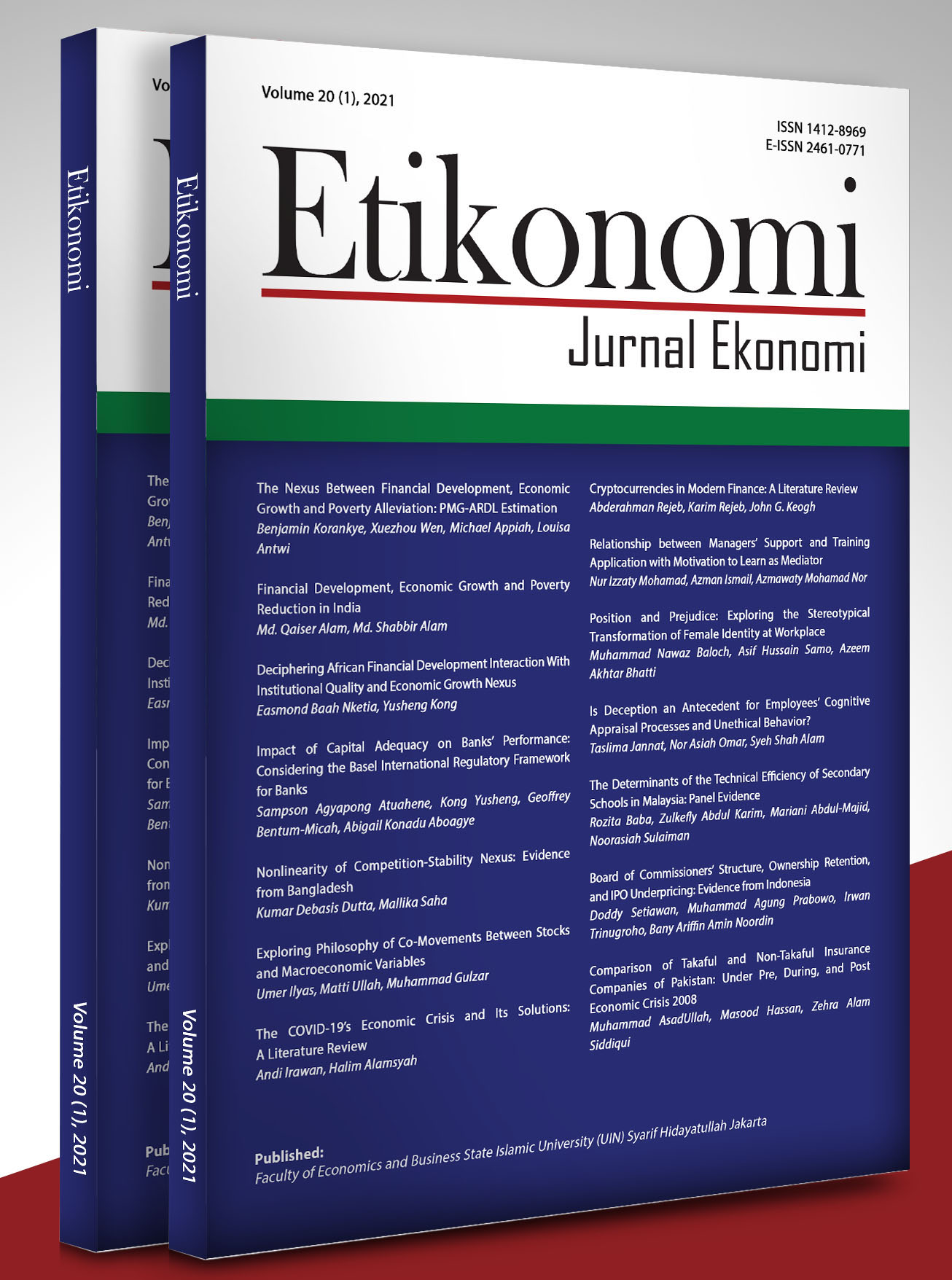Financial Development, Economic Growth and Poverty Reduction in India: An Empirical Evidence
DOI:
https://doi.org/10.15408/etk.v20i1.18417Keywords:
poverty, financial development, economic growth, ARDL, ECMAbstract
The paper examines the response of poverty reduction based on financial development and economic growth in India. The ARDL and ECM based model techniques analyze the long-run and short-run relationship among the variables in the model. The long-run estimates depict that financial development and economic growth have not significantly impacted poverty reduction and, on the other hand, resulted in injecting inequality and becoming attended to wealthier sections of the society. The short-run estimates show that financial development and economic growth have successfully tried to reduce poverty in India. The results flash a long-run nature of poverty in India and need to designs and formulations of policies that should be instrumental in reducing poverty. Impulse Response Functions' application indicates that poverty reduction will act as a catalyst for further poverty reduction in India.
JEL Classification: I32, B26, O40, R15
How to Cite:
Alam, M. Q., & Alam, M. S. (2021). Financial Development, Economic Growth, and Poverty Reduction in India. Etikonomi: Jurnal Ekonomi, 20(1), 13 – 22. https://doi.org/10.15408/etk.v20i1.18417.
Downloads
References
Abosedra, S., Shahbaz, M., & Nawaz, K. (2016). Modeling Causality Between Financial Deepening and Poverty Reduction in Egypt. Social Indicators Research, 126(3), 955-969. https://doi.org/10.1007/s11205-015-0929-2
Azra., Khan, D., Ahmad, E., & Jan, W. U. (2012). Financial Development and Poverty Alleviation: Time Series Evidence from Pakistan. World Applied Sciences Journal, 18(11), 1576-1581. https://doi.org/10.5829/idosi.wasj.2012.18.11.1265.
Berhane, G., & Gardebroek, C. (2011). Does Microfinance Reduce Rural Poverty? Evidence-Based on Household Panel Data from Northern Ethiopia. American Journal of Agricultural Economics, 93(1), 43-55. https://doi.org/10.1093/ajae/aaq126.
Buera, F. J., Kaboski J. P., & Shin, Y. (2012). The Macroeconomics of Microfinance. Working Paper 17905, National Buerau of Economic Research.
Collins, D., Morduch, J., Rutherford, S., & Ruthven, O. (2009). Portfolios of the Poor: How the World's Poor Live on $2 a Day. New Jersey: Princeton University Press.
Dickey, D. A., & Fuller, W. (1981). Likelihood Ratio Statistics for Autoregressive Time Series with a Unit Root. Econometrica, 49(4), 1057-1072
Dollar, D., & Kraay, A. (2002). Growth is Good for the Poor. Journal of Economic Growth, 7(3), 195–225.
Donou-Adonsou, F., & Sylwester, K. (2016). Financial Development and Poverty Reduction in Developing Countries: New Evidence from Banks and Microfinance Institutions. Review of Development Finance, 6(1), 82-90. https://doi.org/10.1016/j.rdf.2016.06.002.
Imai, K. S., & Azam, M. S. (2012). Does Microfinance Reduce Poverty in Bangladesh? New Evidence from Household Panel Data. The Journal of Development Studies, 48(5), 633-653. https://doi.org/10.1080/00220388.2012.661853.
Inoue, T., & Hamori, S. (2012). How Has Financial Deepening Affected Poverty Reduction in India? Empirical Analysis Using State-level Panel Data. Applied Financial Economics, 22(5), 395-408. https://doi.org/10.1080/09603107.2011.613764.
Jalilian, H., & Kirkpatrick, C. (2005). Does Financial Development Contribute to Poverty Reduction? The Journal of Development Studies, 41(4), 636–656. https://doi.org/10.1080/00220380500092754
Jeanneney, S. G., & Kpodar, K. (2011). Financial Development and Poverty reduction: Can there Be a Benefit Without Cost?, Journal of Development Studies, 47(1), 143-16. https://doi.org/10.1080/00220388.2010.506918
Khan, A. D., Ahmad, E., and Jan, W. (2012). Financial Development and Poverty Alleviation: Time Series Evidence from Pakistan. World Applied Sciences Journal, 18 (11), 1576-1581. https://doi.org/10.5829/idosi.wasj.2012.18.11.126.
King, R. J., & Levine, R. (1993). Finance and Growth: Schumpeter Might be Right. Quarterly Journal of Economics, 108(3), 713-737. https://doi.org/10.2307/2118406.
McKinnon, R. I. (1973). Money and Capital in Economic Development, Washington DC: The Brooking Institutions.
MacKinnon, J. G. (1996). Numerical Distribution Functions for Unit Root and Cointegration Tests. Journal of Applied Econometrics, 11(6), 601-618.
Nurkse, R. (1953). Problems of Capital Formation in Underdeveloped Countries. New York: Oxford University Press.
Odhiambo, N. M. (2010). Is Financial Development a Spur to Poverty Reduction? Kenya’s Experience. Journal of Economic Studies, 37(3), 343-353. https://doi.org/10.1108/ 01443581011061311.
Pesaran, M. H., Shin Y., & Smith, R. J. (2001). Bounds Testing Approaches to the Analysis of Level Relationship. Journal of Applied Econometrics, 16(3), 289–326. https://doi.org/10.1002/jae.616.
Phillips, P. C. B., & Perron, P. (1987). Testing for a Unit Root in Time Series Regression. Biometrika, 75(2), 335-346. https://doi.org/10.2307/2336182.
Pradhan, R. P. (2010). The Nexus between Finance, Growth, and Poverty in India: The Cointegration and Causality Approach. Asian Social Science, 6(9), 114–122. https://doi.org/10.5539/ass.v6n9p114.
Ravallion, M., & Datt, G. (2002). Why Has Economic Growth Been More Pro-Poor in Some States of India than Others? Journal of Development Economics, 68(2), 381–400. https://doi.org/10.1016/S0304-3878(02)00018-4.
Rehman, I. U., & Shahbaz, M. (2014). Multivariate-based Granger Causality Between Financial Deepening and Poverty: The Case of Pakistan. Quality & Quantity, 48, 3221–3241. https://doi.org/10.1007/s11135-013-9952-z.
Sehrawat, M., & Giri, A. K. (2016). Financial Development and Poverty Reduction in India: an Empirical Investigation. International Journal of Social Economics, 43(2), 106–122. https://doi.org/10.1108/ijse-01-2014-0019
Sehrawat, M., & Giri, A. K. (2018). The Impact of Financial Development, Economic Growth, Income Inequality on Poverty: Evidence from India. Empirical Economics, 55, 1585-1602. https://doi.org/10.1007/s00181-017-1321-7.
Shaw, E. S. (1973). Financial Deepening in Economic Development. New York: Oxford University Press.
Uddin, G. S., Kyophilavong, P., & Sydee, N. (2012). The Causal Nexus of Banking Sector Development and Poverty Reduction. International Journal of Economics and Financial Issues, 2(3), 304-311.
Uddin, G. S., Shahbaz, M., Arouri, M., & Teulon F. (2014). Financial Development and Poverty Reduction Nexus: A Co-integration and Causality Analysis in Bangladesh. Economic Modelling, 36, 405-412. https://doi.org/10.1016/j.econmod.2013.09.049.
World Bank. (1995). The World Bank annual report 1995. Washington D.C: World Bank.
World Bank. (2019). World Development Indicators 2019. Washington D.C: World Bank.










